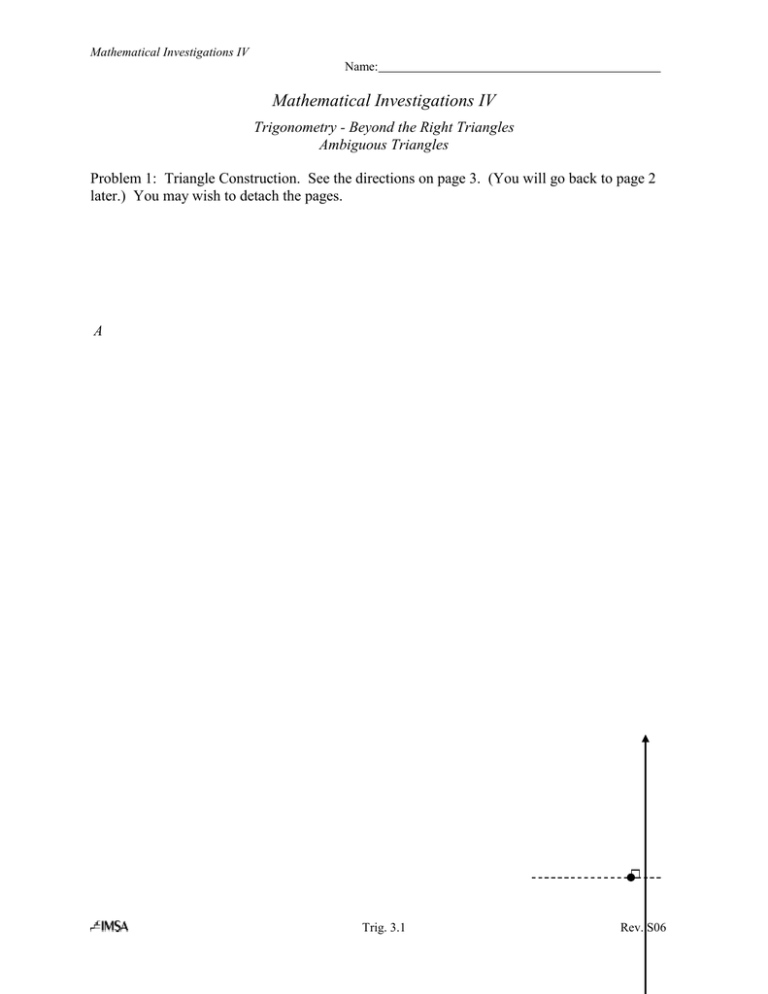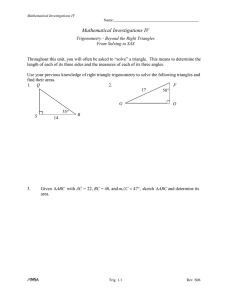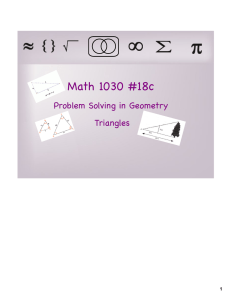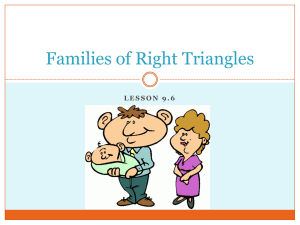Trig 3.4 Ambiguous Case
advertisement

Mathematical Investigations IV Name: Mathematical Investigations IV Trigonometry - Beyond the Right Triangles Ambiguous Triangles Problem 1: Triangle Construction. See the directions on page 3. (You will go back to page 2 later.) You may wish to detach the pages. A Trig. 3.1 Rev. S06 Mathematical Investigations IV Name: 3. In ABC , B 44 and a = 12. Set up the equation for the law of sines with a's and b's. a. If sinA = 1, how many triangles are possible? In this case, find b. b. If sinA > 1, how many triangles are possible? c. If sinA < 1, how many triangles are possible? resulting possible values of b. In this case, find the C a = 12 B ? 44 Note: In the problem below and in future problems, a designation such as S55E is used. In this case, first draw a line due South. From this line, move 55 towards the East. (This will be 35 below the horizontal.) Similarly, a designation of N25W means that one should first draw a line due North. From there, move 25 towards the West (left). 4. A weather forecaster in the tower at DuPage Airport spots a tornado at S55E and this same tornado is spotted from Sears Tower at S35W. The distance between the two observers is approximately 38 miles. How far is the tornado from each observer and how far south of the line connecting the two is the tornado? Note: the Sears Tower is S86oE of the DuPage airport. DuPage Sears Trig. 3.2 Rev. S06 Mathematical Investigations IV Name: Instructions for page 1, Problem 1: a. Note point A on the ray. Construct segment AB of length 10 cm that forms an angle of 49° with the ray with endpoint A. So far, you have a ray, two fixed points, and one segment joining them with fixed length. b. Use a compass to find all possible locations for the third point C of our triangle on the ray so that side BC has length 8 cm. Find all possible measures of C . Label the segments of length 8 and label the points and the angle measures on your drawing. How are these angles related to each other? c. Repeat (b) with side BC having length 6 cm. Then repeat again for a side of length 12 cm. Mark the length of each segment clearly. d. Find the shortest possible length for BC . What is significant about this segment? e. What is the maximum length for side BC ? f. Find all possible lengths for side BC for which there will be two triangles. g. Find all possible lengths for side BC for which there will be no possible triangles. h. Find all possible lengths for side BC for which there will be exactly one triangle. i. Use the Law of Sines on your triangle with a = BC = 6 cm. What happens algebraically? Explain how this is consistent with your drawing. Trig. 3.3 Rev. S06 Mathematical Investigations IV Name: j. Use the Law of Sines to solve your triangle with a = BC = 8 cm. What happens algebraically? Explain how this is consistent with your drawing. What is significant about the sine function that allows this situation to occur? You have just explored the ambiguous case, in which the information given may not uniquely determine a triangle. (In many cases, this will not be obvious from the statement of the problem.) In geometry, you'll recall that SAS information, for example, did determine a triangle. What triangle information were you given above? Was this sufficient for a proof in geometry? k. Use the Law of Sines on your triangle with a = BC = 12 cm. What happens algebraically? Explain how this is consistent with your drawing. 2. FGH , F 18 , f = 8, and g = 12. mG mH h= Next, find problems 3 - 4 on page 2. Trig. 3.4 Rev. S06




